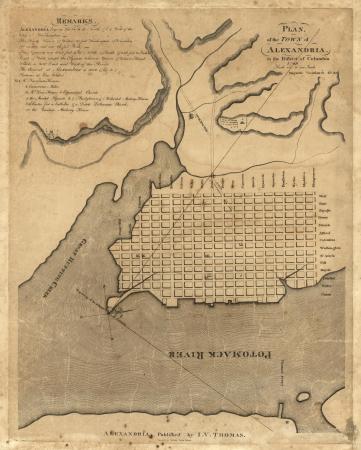Shaped by River and Land
Shaped by the River & the Land
Native Americans have been stewards of this land, the river, and the resources they provide for tens of thousands of years. Europeans saw land as a commodity, and founded Alexandria in 1749 along the banks of the Potomac River.
The town’s access to the deep river channel and its key position below the impassable Great Falls made it an important port in the 1700s, and later a strategic support center during the Civil War. Industry and manufacturing dominated the waterfront until the mid-1900s when the river’s value shifted to the scenic real estate and tourism of today’s Old Town neighborhood. Alexandria’s population grew and spread away from the water. New neighborhoods replaced land once used for agriculture, country estates, and Civil War fortifications. By the mid-20th century, developments and planned communities had largely altered the area.

George Gilpin, 1798. Library of Congress.


How have natural boundaries like water, hills, or valleys shaped your neighborhood?
Sarah O. Strother, raised in Old Town in the 1940s and 50s; interviewed by Paula T. Whitacre, August 19, 2009:
[The Riverfront at Cross Canal] was mostly free. You could go clear to the river. A lot of people sat on the banks and ate and fished or whatever…There was a pier out there, and people used to fish. They’d put them in a basket and carry them home.
Lillian Patterson, speaking about 1940s Old Town; interviewed by Krystyn Moon, May 25, 2021:
Have you heard the expression they took a sow’s ear and made a silk purse out of it? That’s Old Town.
The Bottoms: The Land that is Left
Low-lying land is historically less desirable. Recent migrants and people of lower economic status settled areas of Alexandria that would otherwise be used for industry. In the late 1700s, free Black families living on the fringes of Alexandria’s valuable waterfront held long-term rental agreements with White property owners.
The Bottoms neighborhood, later known as the Dip, was the first free Black neighborhood in Alexandria. During the Civil War, African American refugees developed new neighborhoods in similar low-lying areas, including the Berg.
Over 200 years later, more affordable suburban developments were built within the Four Mile Run floodplain on the northern edge of the city. By the late 20th century, flooding, crime, and outdated infrastructure made the area more affordable than other neighborhoods, leading to political refugees and other migrants settling in the area now known as Arlandria-Chirilagua.
Leonard “Len” Collins; interviewed by Barbara Murray, August 1, 2012:
That whole Arlandria area would flood. And I remember as a Boy Scout we would get rowboats and we would row around assisting people who were having a problem with flooding.